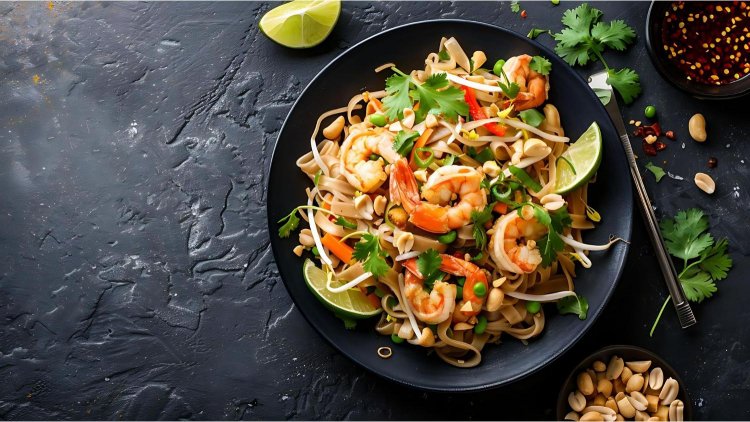A Symphony of Thai Flavors: Mastering the Art of Authentic Pad Thai at Home
If there’s one dish that captures the heart and soul of Thai cuisine, it’s Pad Thai. A perfect harmony of flavors, textures, and aromas, Pad Thai is a culinary masterpiece that has won the hearts of food lovers worldwide. With its rich history rooted in Thailand's street food culture, this dish is more than just a meal—it's an experience. Today, we’re diving into the secrets of making authentic Pad Thai at home, bringing the vibrant flavors of Thailand right to your kitchen.

The Essence of Pad Thai: Understanding the Ingredients
To create an authentic Pad Thai, understanding the ingredients is key. Each component plays a crucial role in creating the dish’s signature balance of sweet, sour, salty, and umami flavors.
1. Rice Noodles: The foundation of Pad Thai, these flat, wide noodles are made from rice flour. They absorb the flavors beautifully, providing a tender yet slightly chewy texture.
2. Tamarind Paste: Tamarind is the soul of Pad Thai’s tangy flavor. This dark, sticky paste is made from tamarind fruit, lending a unique sourness that’s essential to the dish.
3. Fish Sauce: A cornerstone of Thai cooking, fish sauce adds depth and umami to the dish. It’s salty, pungent, and irreplaceable for achieving authentic Pad Thai flavor.
4. Palm Sugar: This unrefined sugar is derived from the sap of palm trees. Its caramel-like sweetness balances the sourness of tamarind and the saltiness of fish sauce.
5. Tofu: Lightly fried tofu cubes add a satisfying bite and soak up the sauce’s flavors.
6. Eggs: Scrambled into the noodles, eggs add richness and a velvety texture.
7. Vegetables: Bean sprouts, garlic chives, and carrots add freshness, crunch, and color.
8. Protein: Traditional Pad Thai often includes shrimp, but chicken or even a combination of both can be used.
9. Peanuts: Crushed roasted peanuts add a nutty crunch that contrasts with the soft noodles.
10. Lime: A squeeze of lime juice brightens up the dish with a final hit of acidity.
Step-by-Step Guide: Crafting Your Perfect Pad Thai
Now that we’ve covered the essentials, it’s time to get cooking. Here’s a detailed guide to creating an authentic Pad Thai that’ll make your taste buds dance.
1. Prepare the Ingredients:
- Soak the Noodles: Begin by soaking 200g of rice noodles in warm water for about 20-30 minutes until they’re pliable but not fully cooked. Drain and set aside.
- Make the Sauce: In a small bowl, combine 3 tablespoons of tamarind paste, 2 tablespoons of fish sauce, 1 tablespoon of palm sugar, and a splash of water. Stir until the sugar dissolves. Adjust the balance of flavors to your liking.
- Chop the Veggies: Slice garlic chives into 2-inch pieces, julienne a small carrot, and rinse a handful of bean sprouts. Crush a handful of roasted peanuts and set them aside.
- Prepare the Protein: If using shrimp, peel and devein them. If using chicken, slice it into thin strips.
2. Cook the Protein and Tofu:
- Heat 2 tablespoons of oil in a large wok over medium-high heat. Add the tofu cubes and stir-fry until golden brown. Remove and set aside.
- In the same wok, add the shrimp or chicken and cook until fully done. Remove and set aside.
3. Scramble the Eggs:
- Add a bit more oil to the wok if needed, and crack two eggs into the center. Let them cook undisturbed for a moment before scrambling them gently with a spatula.
4. Stir-Fry the Noodles:
- Add the soaked noodles to the wok and pour the sauce over them. Toss everything together quickly to coat the noodles evenly. The noodles should absorb most of the sauce and start to soften.
5. Combine Everything:
- Return the tofu, shrimp/chicken, and veggies (except the bean sprouts) to the wok. Stir everything together, allowing the flavors to meld for 2-3 minutes.
6. Garnish and Serve:
- Remove the wok from the heat and stir in the bean sprouts and half of the peanuts. Plate the Pad Thai and garnish with the remaining peanuts, a few extra garlic chives, and lime wedges on the side.
The Finishing Touch: Perfecting Your Pad Thai
Pad Thai is a dish that’s all about balance. The sweetness of palm sugar, the tang of tamarind, the saltiness of fish sauce, and the freshness of lime juice should all come together in harmony. Don’t be afraid to adjust the seasoning as you cook—taste frequently and trust your palate. Whether you’re enjoying it as a quick weeknight dinner or as part of a larger Thai feast, this homemade Pad Thai will bring the flavors of Thailand into your home in the most delicious way.
Disclaimer: The recipes shared on this blog are intended for informational and entertainment purposes only. We do our best to ensure accuracy, but ingredient and preparation variations can alter results. Please use caution and consult a medical professional if you have dietary restrictions or health concerns. The blog and its authors are not liable for any adverse effects or consequences resulting from the use of the recipes provided. Always prioritize your health and safety when cooking.
What's Your Reaction?





















